Logistics and Supply Chain Management Principles: A Case Study
VerifiedAdded on 2022/08/28
|9
|2438
|25
Report
AI Summary
This report provides a comprehensive analysis of logistics and supply chain management principles, focusing on a case study of Hangzhou Yongde Electric Appliances Limited Company, a Chinese manufacturer of electronic components. The report begins by outlining the company's background, core competencies, and its challenges in managing inventory, customer satisfaction, and production efficiency. It explores the interplay between logistics and core functions like production, marketing, finance, and accounting within the organization. The analysis includes an examination of the effectiveness of the company's current order cycle and inventory management systems, highlighting the use of information technology solutions, such as e-commerce platforms. The report then delves into relevant theories and concepts of logistics and supply chain management, including value chain analysis and order fulfillment processes. Finally, it proposes potential improvements based on the findings, aiming to optimize the company's supply chain operations and address the challenges faced in managing inventory and enhancing customer service. The report emphasizes the need for effective supply chain integration to achieve cost rationalization and technological development.
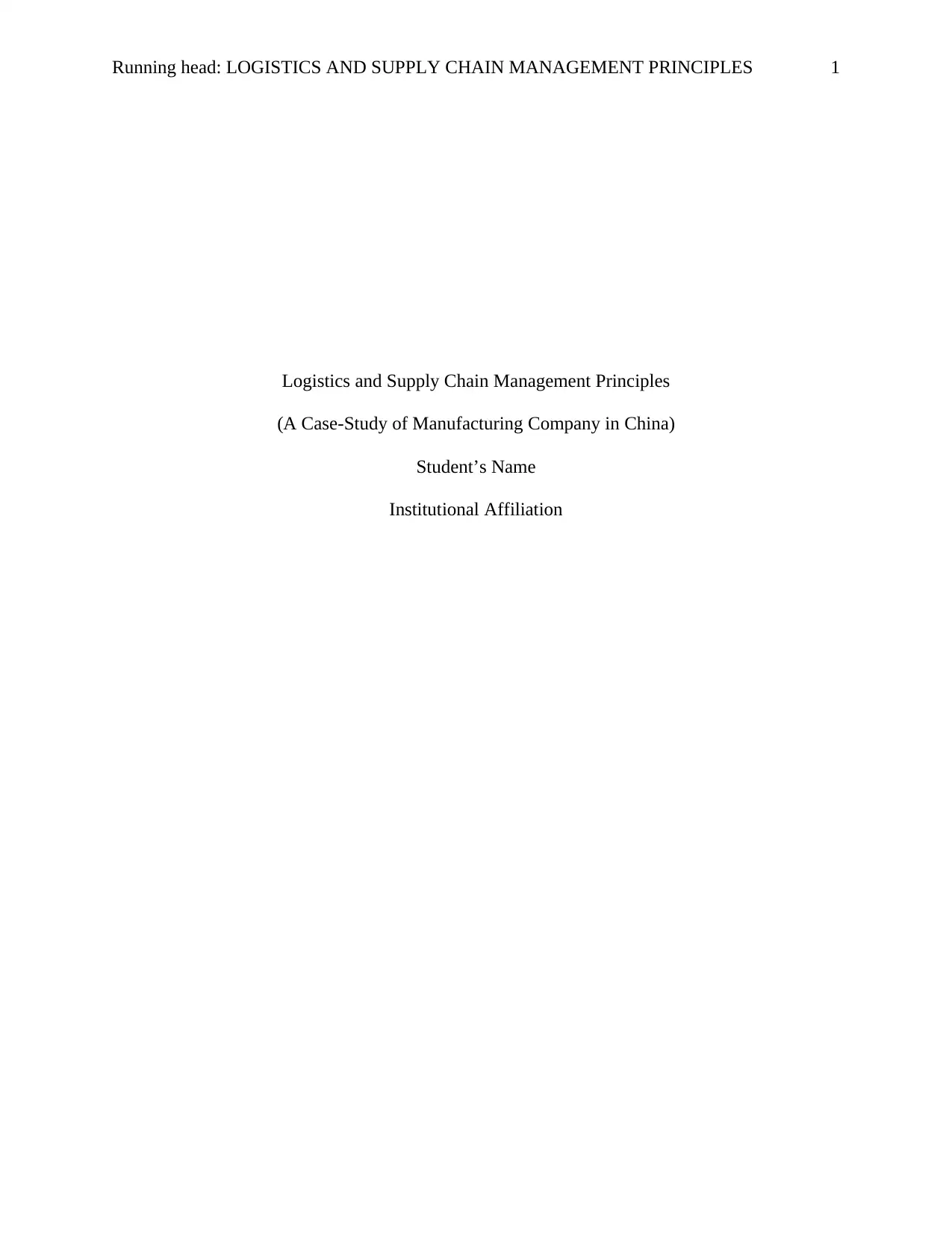
Running head: LOGISTICS AND SUPPLY CHAIN MANAGEMENT PRINCIPLES 1
Logistics and Supply Chain Management Principles
(A Case-Study of Manufacturing Company in China)
Student’s Name
Institutional Affiliation
Logistics and Supply Chain Management Principles
(A Case-Study of Manufacturing Company in China)
Student’s Name
Institutional Affiliation
Paraphrase This Document
Need a fresh take? Get an instant paraphrase of this document with our AI Paraphraser
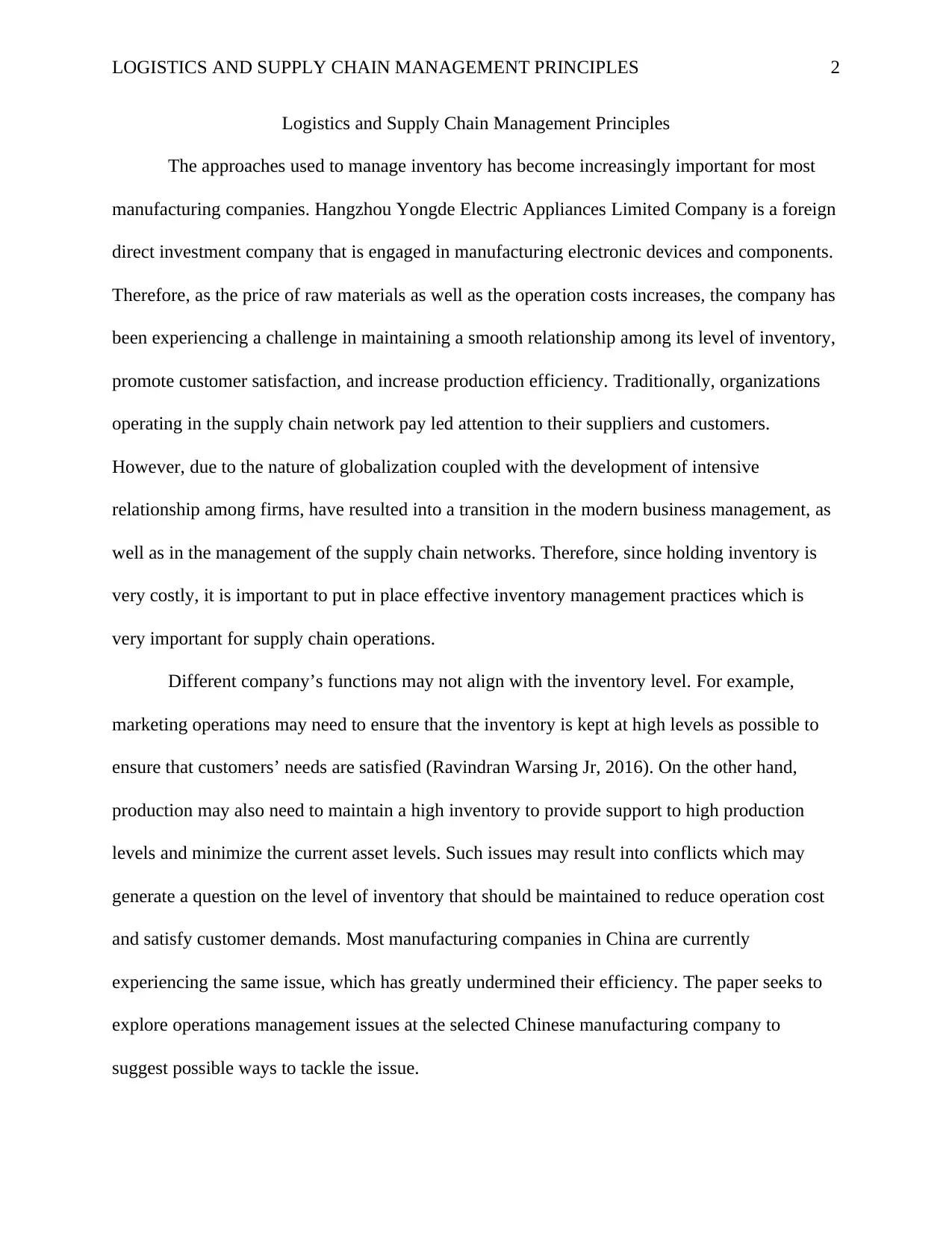
LOGISTICS AND SUPPLY CHAIN MANAGEMENT PRINCIPLES 2
Logistics and Supply Chain Management Principles
The approaches used to manage inventory has become increasingly important for most
manufacturing companies. Hangzhou Yongde Electric Appliances Limited Company is a foreign
direct investment company that is engaged in manufacturing electronic devices and components.
Therefore, as the price of raw materials as well as the operation costs increases, the company has
been experiencing a challenge in maintaining a smooth relationship among its level of inventory,
promote customer satisfaction, and increase production efficiency. Traditionally, organizations
operating in the supply chain network pay led attention to their suppliers and customers.
However, due to the nature of globalization coupled with the development of intensive
relationship among firms, have resulted into a transition in the modern business management, as
well as in the management of the supply chain networks. Therefore, since holding inventory is
very costly, it is important to put in place effective inventory management practices which is
very important for supply chain operations.
Different company’s functions may not align with the inventory level. For example,
marketing operations may need to ensure that the inventory is kept at high levels as possible to
ensure that customers’ needs are satisfied (Ravindran Warsing Jr, 2016). On the other hand,
production may also need to maintain a high inventory to provide support to high production
levels and minimize the current asset levels. Such issues may result into conflicts which may
generate a question on the level of inventory that should be maintained to reduce operation cost
and satisfy customer demands. Most manufacturing companies in China are currently
experiencing the same issue, which has greatly undermined their efficiency. The paper seeks to
explore operations management issues at the selected Chinese manufacturing company to
suggest possible ways to tackle the issue.
Logistics and Supply Chain Management Principles
The approaches used to manage inventory has become increasingly important for most
manufacturing companies. Hangzhou Yongde Electric Appliances Limited Company is a foreign
direct investment company that is engaged in manufacturing electronic devices and components.
Therefore, as the price of raw materials as well as the operation costs increases, the company has
been experiencing a challenge in maintaining a smooth relationship among its level of inventory,
promote customer satisfaction, and increase production efficiency. Traditionally, organizations
operating in the supply chain network pay led attention to their suppliers and customers.
However, due to the nature of globalization coupled with the development of intensive
relationship among firms, have resulted into a transition in the modern business management, as
well as in the management of the supply chain networks. Therefore, since holding inventory is
very costly, it is important to put in place effective inventory management practices which is
very important for supply chain operations.
Different company’s functions may not align with the inventory level. For example,
marketing operations may need to ensure that the inventory is kept at high levels as possible to
ensure that customers’ needs are satisfied (Ravindran Warsing Jr, 2016). On the other hand,
production may also need to maintain a high inventory to provide support to high production
levels and minimize the current asset levels. Such issues may result into conflicts which may
generate a question on the level of inventory that should be maintained to reduce operation cost
and satisfy customer demands. Most manufacturing companies in China are currently
experiencing the same issue, which has greatly undermined their efficiency. The paper seeks to
explore operations management issues at the selected Chinese manufacturing company to
suggest possible ways to tackle the issue.
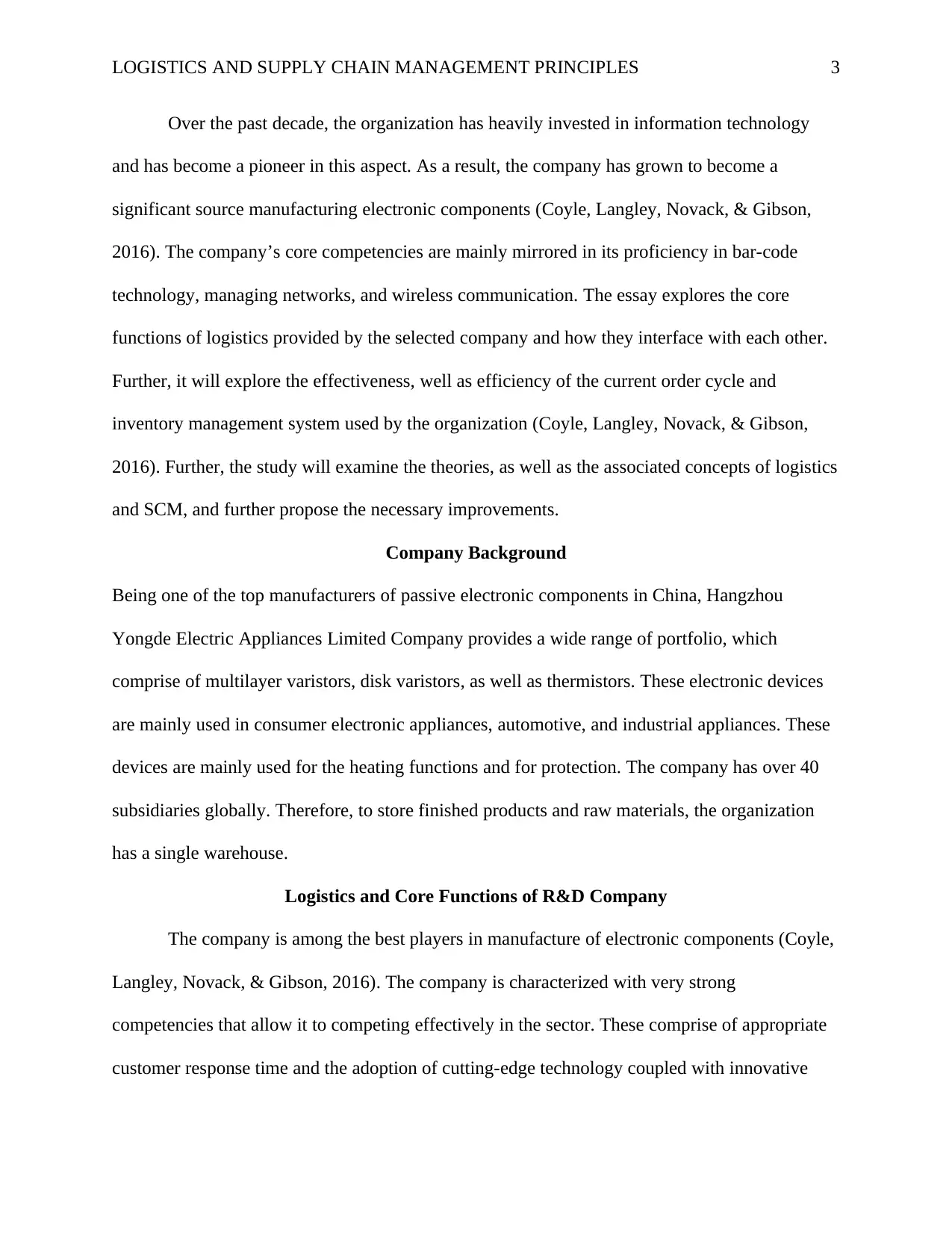
LOGISTICS AND SUPPLY CHAIN MANAGEMENT PRINCIPLES 3
Over the past decade, the organization has heavily invested in information technology
and has become a pioneer in this aspect. As a result, the company has grown to become a
significant source manufacturing electronic components (Coyle, Langley, Novack, & Gibson,
2016). The company’s core competencies are mainly mirrored in its proficiency in bar-code
technology, managing networks, and wireless communication. The essay explores the core
functions of logistics provided by the selected company and how they interface with each other.
Further, it will explore the effectiveness, well as efficiency of the current order cycle and
inventory management system used by the organization (Coyle, Langley, Novack, & Gibson,
2016). Further, the study will examine the theories, as well as the associated concepts of logistics
and SCM, and further propose the necessary improvements.
Company Background
Being one of the top manufacturers of passive electronic components in China, Hangzhou
Yongde Electric Appliances Limited Company provides a wide range of portfolio, which
comprise of multilayer varistors, disk varistors, as well as thermistors. These electronic devices
are mainly used in consumer electronic appliances, automotive, and industrial appliances. These
devices are mainly used for the heating functions and for protection. The company has over 40
subsidiaries globally. Therefore, to store finished products and raw materials, the organization
has a single warehouse.
Logistics and Core Functions of R&D Company
The company is among the best players in manufacture of electronic components (Coyle,
Langley, Novack, & Gibson, 2016). The company is characterized with very strong
competencies that allow it to competing effectively in the sector. These comprise of appropriate
customer response time and the adoption of cutting-edge technology coupled with innovative
Over the past decade, the organization has heavily invested in information technology
and has become a pioneer in this aspect. As a result, the company has grown to become a
significant source manufacturing electronic components (Coyle, Langley, Novack, & Gibson,
2016). The company’s core competencies are mainly mirrored in its proficiency in bar-code
technology, managing networks, and wireless communication. The essay explores the core
functions of logistics provided by the selected company and how they interface with each other.
Further, it will explore the effectiveness, well as efficiency of the current order cycle and
inventory management system used by the organization (Coyle, Langley, Novack, & Gibson,
2016). Further, the study will examine the theories, as well as the associated concepts of logistics
and SCM, and further propose the necessary improvements.
Company Background
Being one of the top manufacturers of passive electronic components in China, Hangzhou
Yongde Electric Appliances Limited Company provides a wide range of portfolio, which
comprise of multilayer varistors, disk varistors, as well as thermistors. These electronic devices
are mainly used in consumer electronic appliances, automotive, and industrial appliances. These
devices are mainly used for the heating functions and for protection. The company has over 40
subsidiaries globally. Therefore, to store finished products and raw materials, the organization
has a single warehouse.
Logistics and Core Functions of R&D Company
The company is among the best players in manufacture of electronic components (Coyle,
Langley, Novack, & Gibson, 2016). The company is characterized with very strong
competencies that allow it to competing effectively in the sector. These comprise of appropriate
customer response time and the adoption of cutting-edge technology coupled with innovative
⊘ This is a preview!⊘
Do you want full access?
Subscribe today to unlock all pages.

Trusted by 1+ million students worldwide
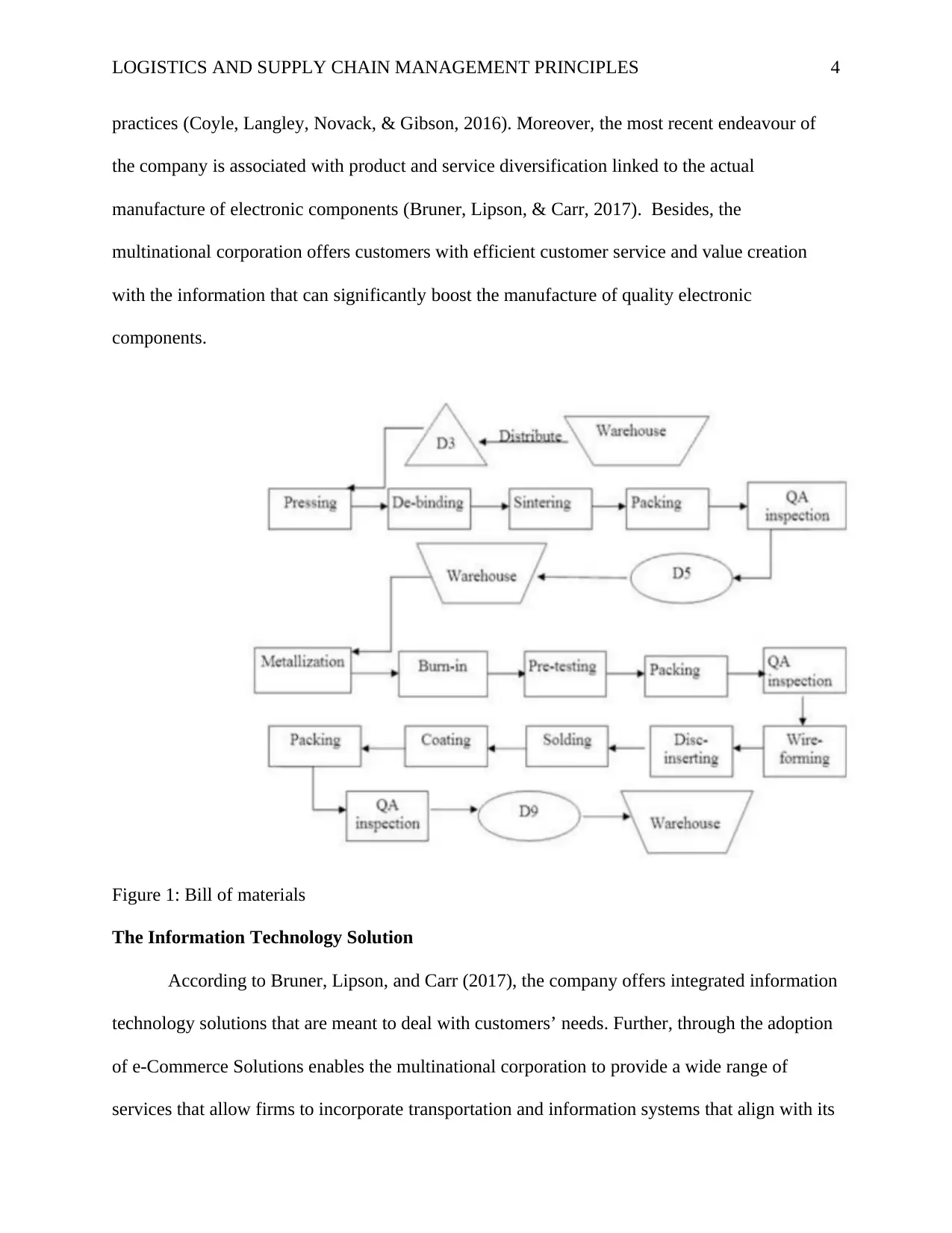
LOGISTICS AND SUPPLY CHAIN MANAGEMENT PRINCIPLES 4
practices (Coyle, Langley, Novack, & Gibson, 2016). Moreover, the most recent endeavour of
the company is associated with product and service diversification linked to the actual
manufacture of electronic components (Bruner, Lipson, & Carr, 2017). Besides, the
multinational corporation offers customers with efficient customer service and value creation
with the information that can significantly boost the manufacture of quality electronic
components.
Figure 1: Bill of materials
The Information Technology Solution
According to Bruner, Lipson, and Carr (2017), the company offers integrated information
technology solutions that are meant to deal with customers’ needs. Further, through the adoption
of e-Commerce Solutions enables the multinational corporation to provide a wide range of
services that allow firms to incorporate transportation and information systems that align with its
practices (Coyle, Langley, Novack, & Gibson, 2016). Moreover, the most recent endeavour of
the company is associated with product and service diversification linked to the actual
manufacture of electronic components (Bruner, Lipson, & Carr, 2017). Besides, the
multinational corporation offers customers with efficient customer service and value creation
with the information that can significantly boost the manufacture of quality electronic
components.
Figure 1: Bill of materials
The Information Technology Solution
According to Bruner, Lipson, and Carr (2017), the company offers integrated information
technology solutions that are meant to deal with customers’ needs. Further, through the adoption
of e-Commerce Solutions enables the multinational corporation to provide a wide range of
services that allow firms to incorporate transportation and information systems that align with its
Paraphrase This Document
Need a fresh take? Get an instant paraphrase of this document with our AI Paraphraser
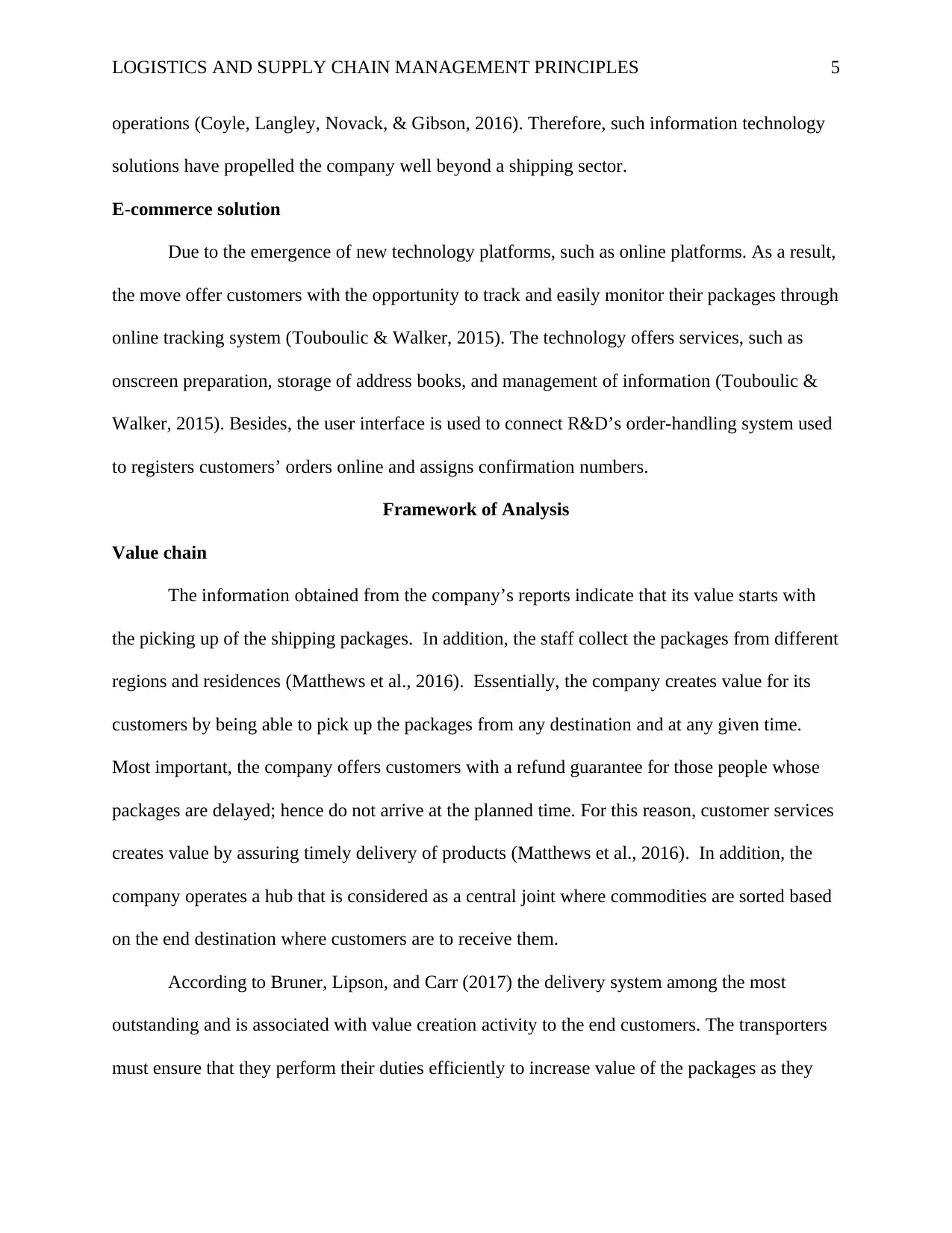
LOGISTICS AND SUPPLY CHAIN MANAGEMENT PRINCIPLES 5
operations (Coyle, Langley, Novack, & Gibson, 2016). Therefore, such information technology
solutions have propelled the company well beyond a shipping sector.
E-commerce solution
Due to the emergence of new technology platforms, such as online platforms. As a result,
the move offer customers with the opportunity to track and easily monitor their packages through
online tracking system (Touboulic & Walker, 2015). The technology offers services, such as
onscreen preparation, storage of address books, and management of information (Touboulic &
Walker, 2015). Besides, the user interface is used to connect R&D’s order-handling system used
to registers customers’ orders online and assigns confirmation numbers.
Framework of Analysis
Value chain
The information obtained from the company’s reports indicate that its value starts with
the picking up of the shipping packages. In addition, the staff collect the packages from different
regions and residences (Matthews et al., 2016). Essentially, the company creates value for its
customers by being able to pick up the packages from any destination and at any given time.
Most important, the company offers customers with a refund guarantee for those people whose
packages are delayed; hence do not arrive at the planned time. For this reason, customer services
creates value by assuring timely delivery of products (Matthews et al., 2016). In addition, the
company operates a hub that is considered as a central joint where commodities are sorted based
on the end destination where customers are to receive them.
According to Bruner, Lipson, and Carr (2017) the delivery system among the most
outstanding and is associated with value creation activity to the end customers. The transporters
must ensure that they perform their duties efficiently to increase value of the packages as they
operations (Coyle, Langley, Novack, & Gibson, 2016). Therefore, such information technology
solutions have propelled the company well beyond a shipping sector.
E-commerce solution
Due to the emergence of new technology platforms, such as online platforms. As a result,
the move offer customers with the opportunity to track and easily monitor their packages through
online tracking system (Touboulic & Walker, 2015). The technology offers services, such as
onscreen preparation, storage of address books, and management of information (Touboulic &
Walker, 2015). Besides, the user interface is used to connect R&D’s order-handling system used
to registers customers’ orders online and assigns confirmation numbers.
Framework of Analysis
Value chain
The information obtained from the company’s reports indicate that its value starts with
the picking up of the shipping packages. In addition, the staff collect the packages from different
regions and residences (Matthews et al., 2016). Essentially, the company creates value for its
customers by being able to pick up the packages from any destination and at any given time.
Most important, the company offers customers with a refund guarantee for those people whose
packages are delayed; hence do not arrive at the planned time. For this reason, customer services
creates value by assuring timely delivery of products (Matthews et al., 2016). In addition, the
company operates a hub that is considered as a central joint where commodities are sorted based
on the end destination where customers are to receive them.
According to Bruner, Lipson, and Carr (2017) the delivery system among the most
outstanding and is associated with value creation activity to the end customers. The transporters
must ensure that they perform their duties efficiently to increase value of the packages as they
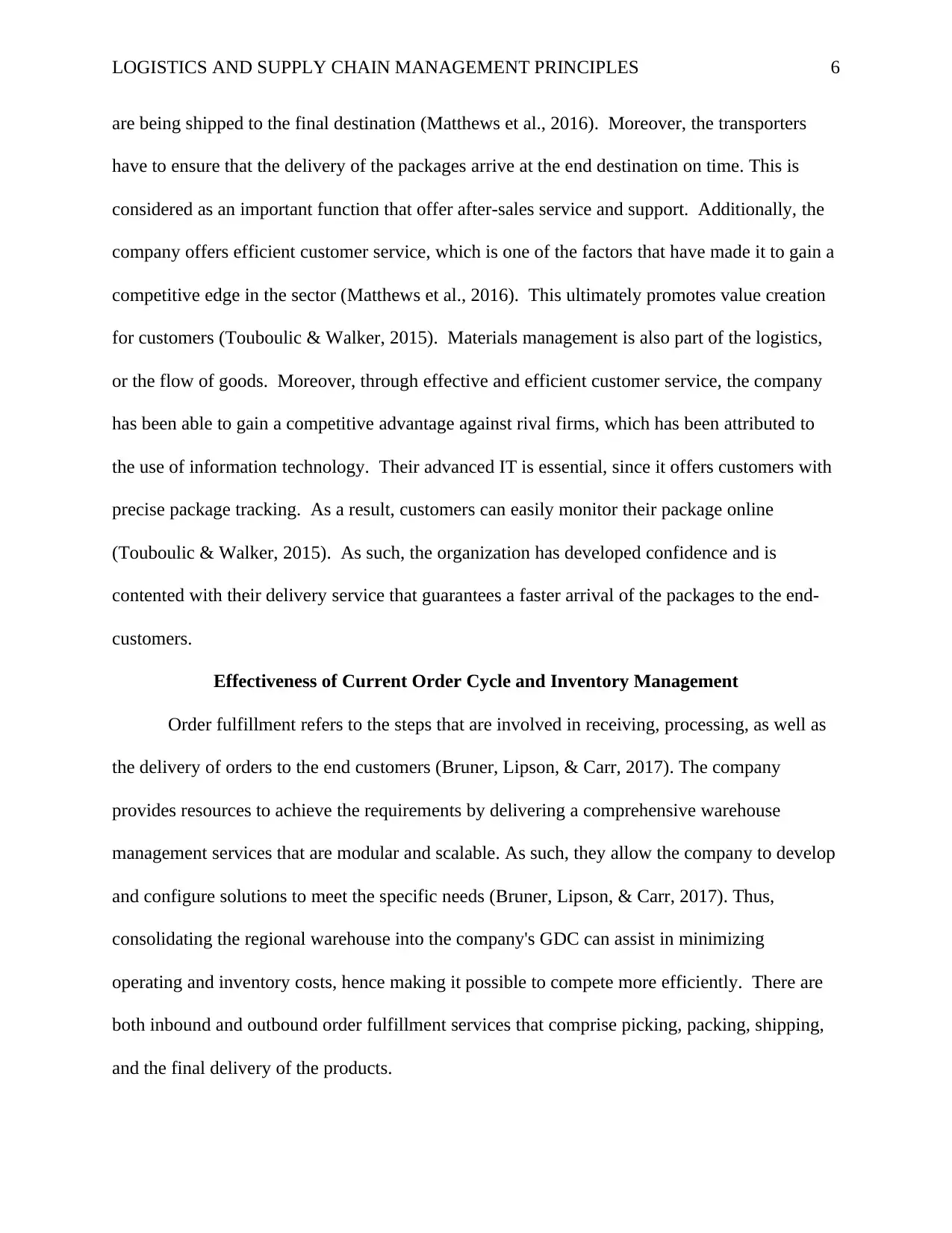
LOGISTICS AND SUPPLY CHAIN MANAGEMENT PRINCIPLES 6
are being shipped to the final destination (Matthews et al., 2016). Moreover, the transporters
have to ensure that the delivery of the packages arrive at the end destination on time. This is
considered as an important function that offer after-sales service and support. Additionally, the
company offers efficient customer service, which is one of the factors that have made it to gain a
competitive edge in the sector (Matthews et al., 2016). This ultimately promotes value creation
for customers (Touboulic & Walker, 2015). Materials management is also part of the logistics,
or the flow of goods. Moreover, through effective and efficient customer service, the company
has been able to gain a competitive advantage against rival firms, which has been attributed to
the use of information technology. Their advanced IT is essential, since it offers customers with
precise package tracking. As a result, customers can easily monitor their package online
(Touboulic & Walker, 2015). As such, the organization has developed confidence and is
contented with their delivery service that guarantees a faster arrival of the packages to the end-
customers.
Effectiveness of Current Order Cycle and Inventory Management
Order fulfillment refers to the steps that are involved in receiving, processing, as well as
the delivery of orders to the end customers (Bruner, Lipson, & Carr, 2017). The company
provides resources to achieve the requirements by delivering a comprehensive warehouse
management services that are modular and scalable. As such, they allow the company to develop
and configure solutions to meet the specific needs (Bruner, Lipson, & Carr, 2017). Thus,
consolidating the regional warehouse into the company's GDC can assist in minimizing
operating and inventory costs, hence making it possible to compete more efficiently. There are
both inbound and outbound order fulfillment services that comprise picking, packing, shipping,
and the final delivery of the products.
are being shipped to the final destination (Matthews et al., 2016). Moreover, the transporters
have to ensure that the delivery of the packages arrive at the end destination on time. This is
considered as an important function that offer after-sales service and support. Additionally, the
company offers efficient customer service, which is one of the factors that have made it to gain a
competitive edge in the sector (Matthews et al., 2016). This ultimately promotes value creation
for customers (Touboulic & Walker, 2015). Materials management is also part of the logistics,
or the flow of goods. Moreover, through effective and efficient customer service, the company
has been able to gain a competitive advantage against rival firms, which has been attributed to
the use of information technology. Their advanced IT is essential, since it offers customers with
precise package tracking. As a result, customers can easily monitor their package online
(Touboulic & Walker, 2015). As such, the organization has developed confidence and is
contented with their delivery service that guarantees a faster arrival of the packages to the end-
customers.
Effectiveness of Current Order Cycle and Inventory Management
Order fulfillment refers to the steps that are involved in receiving, processing, as well as
the delivery of orders to the end customers (Bruner, Lipson, & Carr, 2017). The company
provides resources to achieve the requirements by delivering a comprehensive warehouse
management services that are modular and scalable. As such, they allow the company to develop
and configure solutions to meet the specific needs (Bruner, Lipson, & Carr, 2017). Thus,
consolidating the regional warehouse into the company's GDC can assist in minimizing
operating and inventory costs, hence making it possible to compete more efficiently. There are
both inbound and outbound order fulfillment services that comprise picking, packing, shipping,
and the final delivery of the products.
⊘ This is a preview!⊘
Do you want full access?
Subscribe today to unlock all pages.

Trusted by 1+ million students worldwide
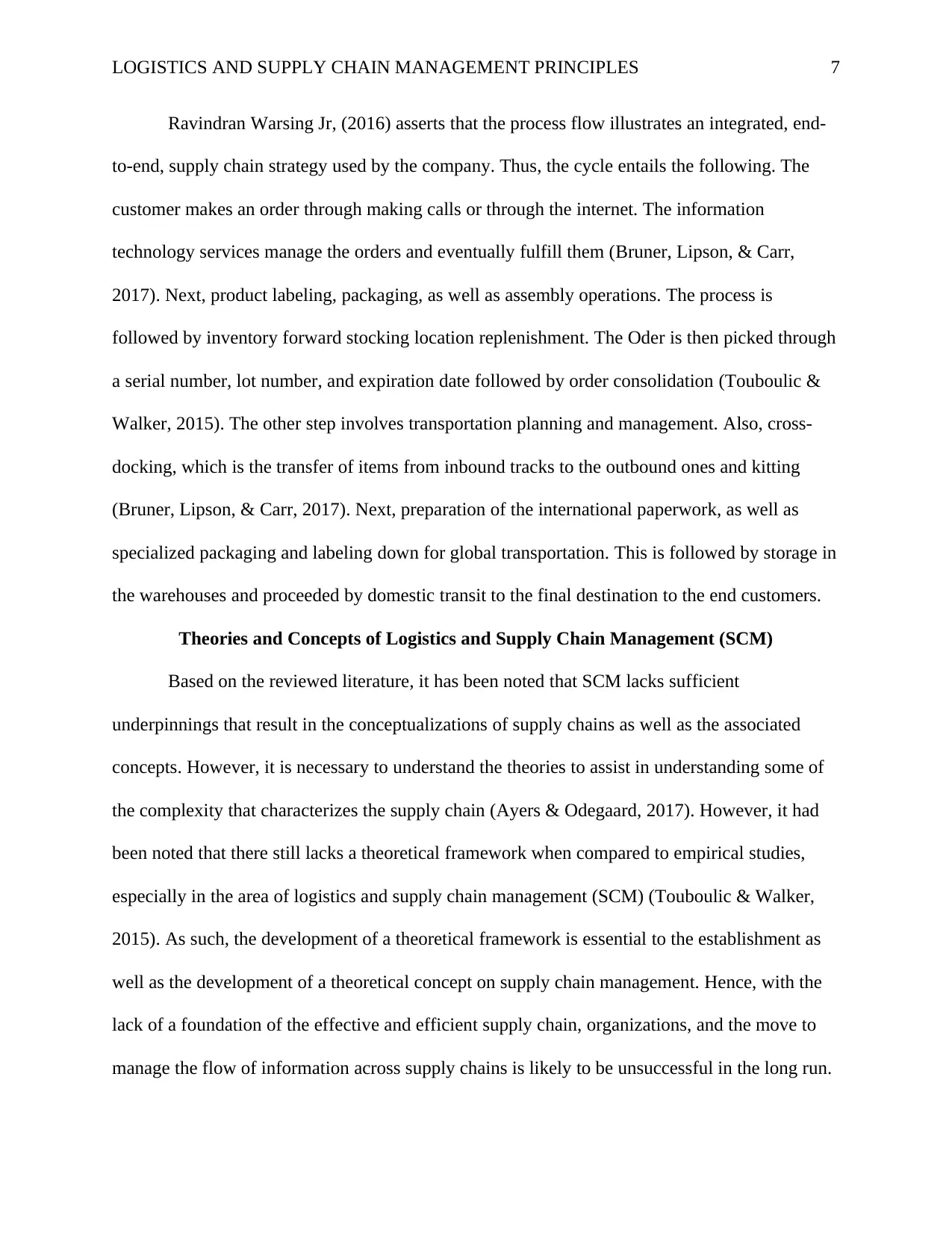
LOGISTICS AND SUPPLY CHAIN MANAGEMENT PRINCIPLES 7
Ravindran Warsing Jr, (2016) asserts that the process flow illustrates an integrated, end-
to-end, supply chain strategy used by the company. Thus, the cycle entails the following. The
customer makes an order through making calls or through the internet. The information
technology services manage the orders and eventually fulfill them (Bruner, Lipson, & Carr,
2017). Next, product labeling, packaging, as well as assembly operations. The process is
followed by inventory forward stocking location replenishment. The Oder is then picked through
a serial number, lot number, and expiration date followed by order consolidation (Touboulic &
Walker, 2015). The other step involves transportation planning and management. Also, cross-
docking, which is the transfer of items from inbound tracks to the outbound ones and kitting
(Bruner, Lipson, & Carr, 2017). Next, preparation of the international paperwork, as well as
specialized packaging and labeling down for global transportation. This is followed by storage in
the warehouses and proceeded by domestic transit to the final destination to the end customers.
Theories and Concepts of Logistics and Supply Chain Management (SCM)
Based on the reviewed literature, it has been noted that SCM lacks sufficient
underpinnings that result in the conceptualizations of supply chains as well as the associated
concepts. However, it is necessary to understand the theories to assist in understanding some of
the complexity that characterizes the supply chain (Ayers & Odegaard, 2017). However, it had
been noted that there still lacks a theoretical framework when compared to empirical studies,
especially in the area of logistics and supply chain management (SCM) (Touboulic & Walker,
2015). As such, the development of a theoretical framework is essential to the establishment as
well as the development of a theoretical concept on supply chain management. Hence, with the
lack of a foundation of the effective and efficient supply chain, organizations, and the move to
manage the flow of information across supply chains is likely to be unsuccessful in the long run.
Ravindran Warsing Jr, (2016) asserts that the process flow illustrates an integrated, end-
to-end, supply chain strategy used by the company. Thus, the cycle entails the following. The
customer makes an order through making calls or through the internet. The information
technology services manage the orders and eventually fulfill them (Bruner, Lipson, & Carr,
2017). Next, product labeling, packaging, as well as assembly operations. The process is
followed by inventory forward stocking location replenishment. The Oder is then picked through
a serial number, lot number, and expiration date followed by order consolidation (Touboulic &
Walker, 2015). The other step involves transportation planning and management. Also, cross-
docking, which is the transfer of items from inbound tracks to the outbound ones and kitting
(Bruner, Lipson, & Carr, 2017). Next, preparation of the international paperwork, as well as
specialized packaging and labeling down for global transportation. This is followed by storage in
the warehouses and proceeded by domestic transit to the final destination to the end customers.
Theories and Concepts of Logistics and Supply Chain Management (SCM)
Based on the reviewed literature, it has been noted that SCM lacks sufficient
underpinnings that result in the conceptualizations of supply chains as well as the associated
concepts. However, it is necessary to understand the theories to assist in understanding some of
the complexity that characterizes the supply chain (Ayers & Odegaard, 2017). However, it had
been noted that there still lacks a theoretical framework when compared to empirical studies,
especially in the area of logistics and supply chain management (SCM) (Touboulic & Walker,
2015). As such, the development of a theoretical framework is essential to the establishment as
well as the development of a theoretical concept on supply chain management. Hence, with the
lack of a foundation of the effective and efficient supply chain, organizations, and the move to
manage the flow of information across supply chains is likely to be unsuccessful in the long run.
Paraphrase This Document
Need a fresh take? Get an instant paraphrase of this document with our AI Paraphraser
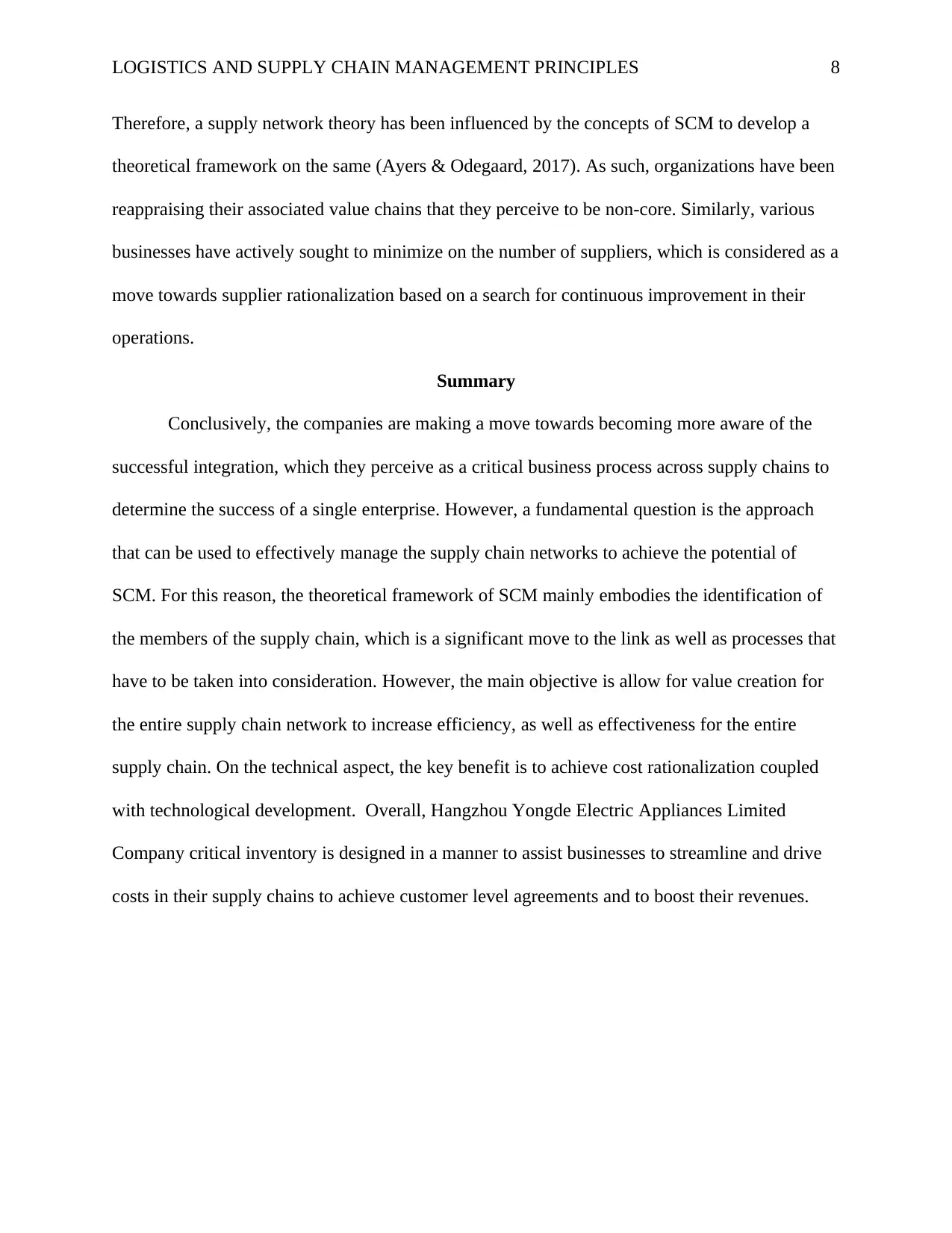
LOGISTICS AND SUPPLY CHAIN MANAGEMENT PRINCIPLES 8
Therefore, a supply network theory has been influenced by the concepts of SCM to develop a
theoretical framework on the same (Ayers & Odegaard, 2017). As such, organizations have been
reappraising their associated value chains that they perceive to be non-core. Similarly, various
businesses have actively sought to minimize on the number of suppliers, which is considered as a
move towards supplier rationalization based on a search for continuous improvement in their
operations.
Summary
Conclusively, the companies are making a move towards becoming more aware of the
successful integration, which they perceive as a critical business process across supply chains to
determine the success of a single enterprise. However, a fundamental question is the approach
that can be used to effectively manage the supply chain networks to achieve the potential of
SCM. For this reason, the theoretical framework of SCM mainly embodies the identification of
the members of the supply chain, which is a significant move to the link as well as processes that
have to be taken into consideration. However, the main objective is allow for value creation for
the entire supply chain network to increase efficiency, as well as effectiveness for the entire
supply chain. On the technical aspect, the key benefit is to achieve cost rationalization coupled
with technological development. Overall, Hangzhou Yongde Electric Appliances Limited
Company critical inventory is designed in a manner to assist businesses to streamline and drive
costs in their supply chains to achieve customer level agreements and to boost their revenues.
Therefore, a supply network theory has been influenced by the concepts of SCM to develop a
theoretical framework on the same (Ayers & Odegaard, 2017). As such, organizations have been
reappraising their associated value chains that they perceive to be non-core. Similarly, various
businesses have actively sought to minimize on the number of suppliers, which is considered as a
move towards supplier rationalization based on a search for continuous improvement in their
operations.
Summary
Conclusively, the companies are making a move towards becoming more aware of the
successful integration, which they perceive as a critical business process across supply chains to
determine the success of a single enterprise. However, a fundamental question is the approach
that can be used to effectively manage the supply chain networks to achieve the potential of
SCM. For this reason, the theoretical framework of SCM mainly embodies the identification of
the members of the supply chain, which is a significant move to the link as well as processes that
have to be taken into consideration. However, the main objective is allow for value creation for
the entire supply chain network to increase efficiency, as well as effectiveness for the entire
supply chain. On the technical aspect, the key benefit is to achieve cost rationalization coupled
with technological development. Overall, Hangzhou Yongde Electric Appliances Limited
Company critical inventory is designed in a manner to assist businesses to streamline and drive
costs in their supply chains to achieve customer level agreements and to boost their revenues.
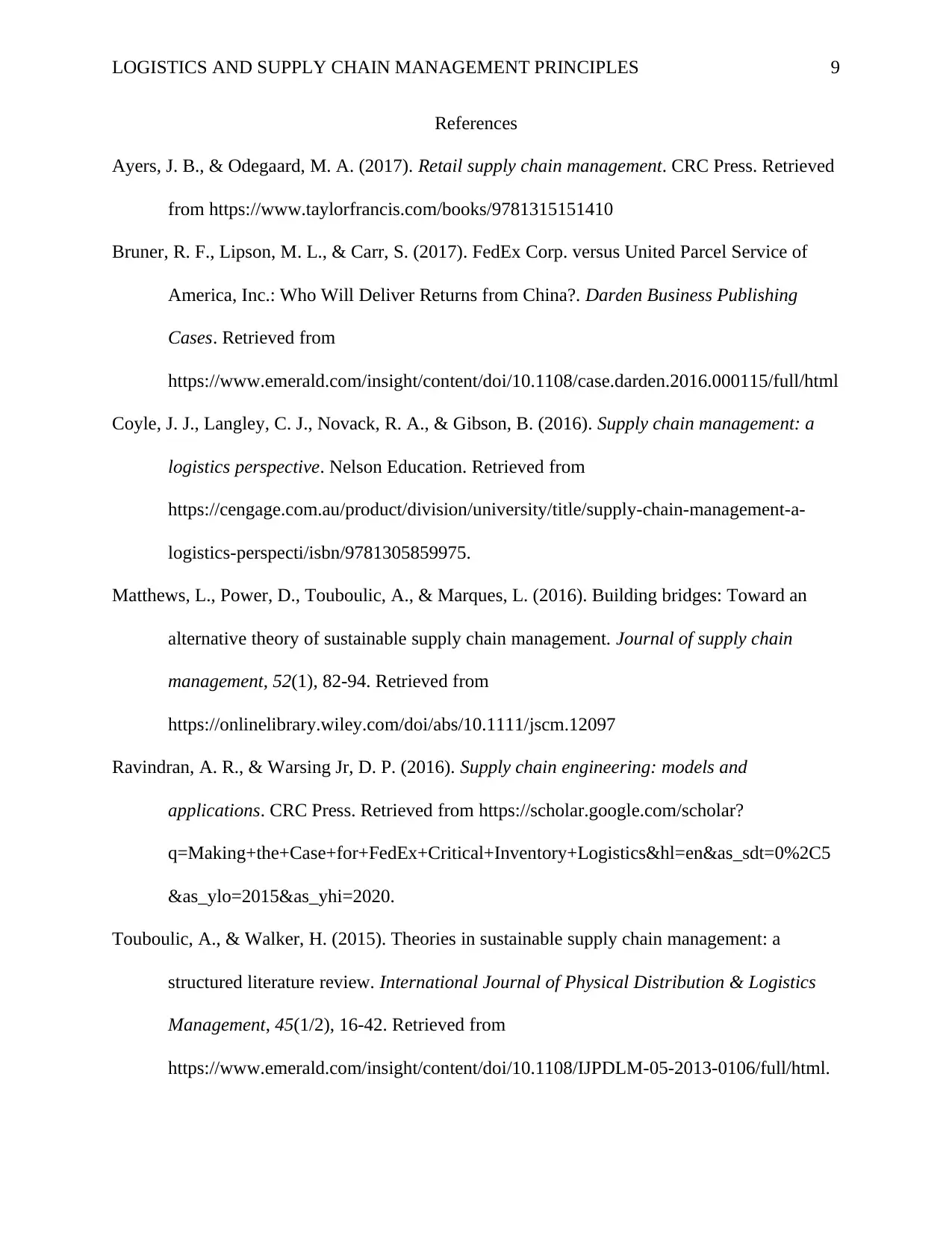
LOGISTICS AND SUPPLY CHAIN MANAGEMENT PRINCIPLES 9
References
Ayers, J. B., & Odegaard, M. A. (2017). Retail supply chain management. CRC Press. Retrieved
from https://www.taylorfrancis.com/books/9781315151410
Bruner, R. F., Lipson, M. L., & Carr, S. (2017). FedEx Corp. versus United Parcel Service of
America, Inc.: Who Will Deliver Returns from China?. Darden Business Publishing
Cases. Retrieved from
https://www.emerald.com/insight/content/doi/10.1108/case.darden.2016.000115/full/html
Coyle, J. J., Langley, C. J., Novack, R. A., & Gibson, B. (2016). Supply chain management: a
logistics perspective. Nelson Education. Retrieved from
https://cengage.com.au/product/division/university/title/supply-chain-management-a-
logistics-perspecti/isbn/9781305859975.
Matthews, L., Power, D., Touboulic, A., & Marques, L. (2016). Building bridges: Toward an
alternative theory of sustainable supply chain management. Journal of supply chain
management, 52(1), 82-94. Retrieved from
https://onlinelibrary.wiley.com/doi/abs/10.1111/jscm.12097
Ravindran, A. R., & Warsing Jr, D. P. (2016). Supply chain engineering: models and
applications. CRC Press. Retrieved from https://scholar.google.com/scholar?
q=Making+the+Case+for+FedEx+Critical+Inventory+Logistics&hl=en&as_sdt=0%2C5
&as_ylo=2015&as_yhi=2020.
Touboulic, A., & Walker, H. (2015). Theories in sustainable supply chain management: a
structured literature review. International Journal of Physical Distribution & Logistics
Management, 45(1/2), 16-42. Retrieved from
https://www.emerald.com/insight/content/doi/10.1108/IJPDLM-05-2013-0106/full/html.
References
Ayers, J. B., & Odegaard, M. A. (2017). Retail supply chain management. CRC Press. Retrieved
from https://www.taylorfrancis.com/books/9781315151410
Bruner, R. F., Lipson, M. L., & Carr, S. (2017). FedEx Corp. versus United Parcel Service of
America, Inc.: Who Will Deliver Returns from China?. Darden Business Publishing
Cases. Retrieved from
https://www.emerald.com/insight/content/doi/10.1108/case.darden.2016.000115/full/html
Coyle, J. J., Langley, C. J., Novack, R. A., & Gibson, B. (2016). Supply chain management: a
logistics perspective. Nelson Education. Retrieved from
https://cengage.com.au/product/division/university/title/supply-chain-management-a-
logistics-perspecti/isbn/9781305859975.
Matthews, L., Power, D., Touboulic, A., & Marques, L. (2016). Building bridges: Toward an
alternative theory of sustainable supply chain management. Journal of supply chain
management, 52(1), 82-94. Retrieved from
https://onlinelibrary.wiley.com/doi/abs/10.1111/jscm.12097
Ravindran, A. R., & Warsing Jr, D. P. (2016). Supply chain engineering: models and
applications. CRC Press. Retrieved from https://scholar.google.com/scholar?
q=Making+the+Case+for+FedEx+Critical+Inventory+Logistics&hl=en&as_sdt=0%2C5
&as_ylo=2015&as_yhi=2020.
Touboulic, A., & Walker, H. (2015). Theories in sustainable supply chain management: a
structured literature review. International Journal of Physical Distribution & Logistics
Management, 45(1/2), 16-42. Retrieved from
https://www.emerald.com/insight/content/doi/10.1108/IJPDLM-05-2013-0106/full/html.
⊘ This is a preview!⊘
Do you want full access?
Subscribe today to unlock all pages.

Trusted by 1+ million students worldwide
1 out of 9
Related Documents
Your All-in-One AI-Powered Toolkit for Academic Success.
+13062052269
info@desklib.com
Available 24*7 on WhatsApp / Email
![[object Object]](/_next/static/media/star-bottom.7253800d.svg)
Unlock your academic potential
Copyright © 2020–2025 A2Z Services. All Rights Reserved. Developed and managed by ZUCOL.




